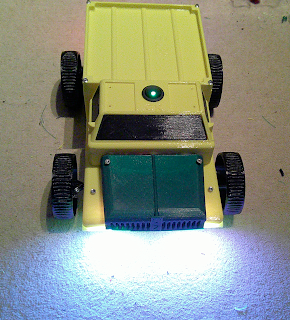The Challenge
The Minesweeper challenge requires the competing robot to reposition itself to one of sixteen squares in a 4x4 matrix when that square is illuminated as red from the normal white. Covering any part of the square with the robot counts as covering it. and thus mine found. Once the robot has remained over a square for one second, then another square is randomly selected and illuminated, to which the robot must move next.
A total of 20 squares can be illuminated for each robots run and a run ends after either 5 minutes or all 20 mines have been found. If all 20 are found then the time taken to complete the run is recorded and points awarded to the robot according to the
formula system.
There are points awarded for each square found, 50 for autonomous robots and 35 for remote controlled robots. All competitors get 150 points extra for finding more than 10 mines. Just for competing, autonomous robots get 250 points, so entering as autonomous is worthwhile even if the robot can only move briefly. There are therefore a total of 1550 points available for autonomous robots and 1300 for remote controlled robots.
Analysis
Using conventional wheels driving to a square will require first steering, and then driving. Using tank steering this would be a simple manoeuvrer, but with Akerman steering this could become more complex and in the confines of the 4x4 matrix more longwinded. The use of mecanum or omnidirectional wheels would make moving to a square more direct as the robot only has to set the drive parameters to move in the correct direction. Sticking to the intersections would mean that the robot would only have to move the minimum distance to succeed in finding a square and also covering the central intersection equally as effective.
For remote control and autonomous robots, once a robot has gained an aligned position over an intersection, instead of analogue steering, commands could be to move 400mm on the required vector simplifying actions and potentially making the robot more reliable.
Each square is 400mm on each side so a robot positioned on an intersection could cover four squares. With a random selection, if a robot can get itself parked on one of these intersections then there is a 1 in 4 chance that the next illuminated square is already covered. A not unreasonable tactic for an autonomous robot is to drive between these intersection points in a circular motion, stopping when it's detected that a square is illuminated. This could be a slightly more complex line following algorithm, ignoring other lines and stopping when the colour change is detected. This strategy would assist any type of steering. If it takes a robot 10 seconds to do a circuit of the squares, 3.2m, it might be expected to complete all 20 squares in less than 100 seconds.
Detecting a red square versus a white square for autonomous robots is a matter of both detecting the red and it's position. If the action of the robot is to actively search for the red, as in the intersection follower above, then the mechanism is built into the movement and detectors built into the corners of the robot might be expected to be enough.
The detector above will give a precise colour measurement. Simpler detectors could be devised, with say an LDR covered with a green or blue coloured filter, and would give a good signal and no signal if over white or red, dodging the black lines as it goes! A one minute calibration period is allowed for each robot before each competitive run to allow for adjustments so any detector can be optimised.
Using this method also needs the dimensions of the robot taking into account and the detectors may need to be a permanent feature of the robot.
A popular choice may be a colour camera which can be used in simple or complex ways. Again, deploying a separate camera to the corners may be an effective way of determining the position of the red square when the robot passes over it, though may be more complex than imagined. Mounting a camera in a single line of vision would require the robot to reposition itself to find a red square, and then drive the robot to locate it. This may be effective but also time consuming as the robot searches and illuminated squares close to the robot may be difficult to see. Placing the camera on a rotating platform may help, though some additional engineering may be required, but would speed the process as only the camera would have to be used to locate a red square and a tilt mechanism could be used to view squares close by.
Placing a camera high above the robot would give a better overall view of the arena and thus make the task of finding an illuminated square easier. If this camera were also a wide angle camera and positioned pointing straight down, then it could feasibly observe the whole of the arena and thus detect a lit red square without movement. For a robot navigating to a square using this camera method the task is easier because all that is required is that the navigation moves the red square as close to the centre of the cameras view as possible.
If mounting the camera above the robot doesn't give an adequate view, or the camera angle isn't wide enough, the camera could be mounted on the top of the robot pointing upwards towards either a plain or convex mirror.
These are just a few ideas for solving this challenge, not sure which we'll use yet but the camera and mirror might be easiest, we'll just see what we do and might come up with another idea.




















































